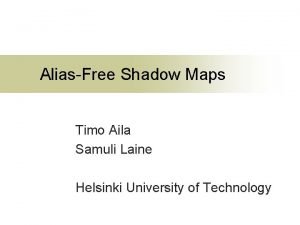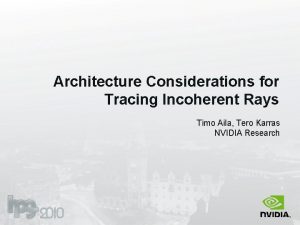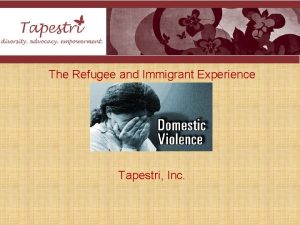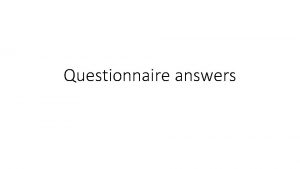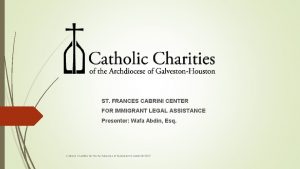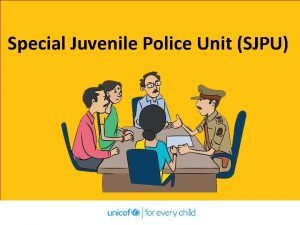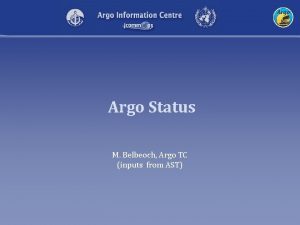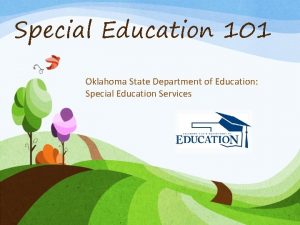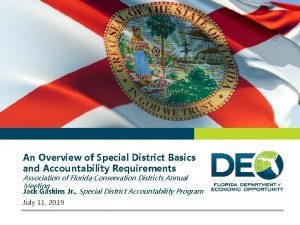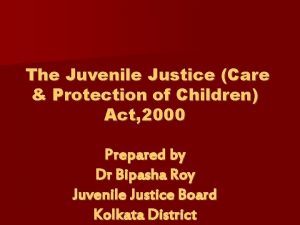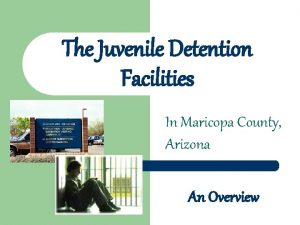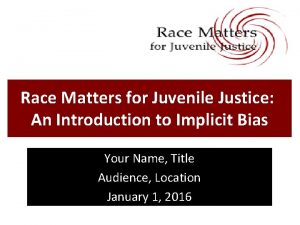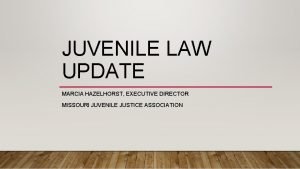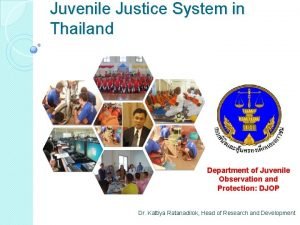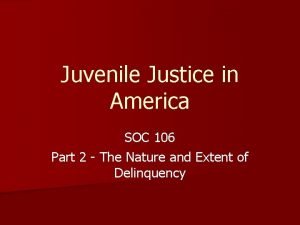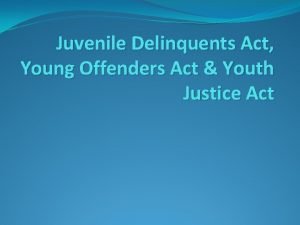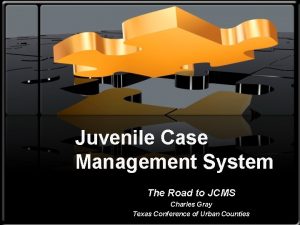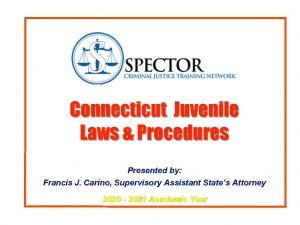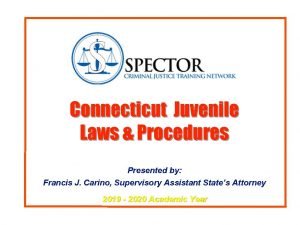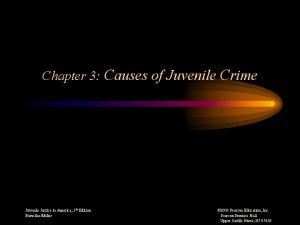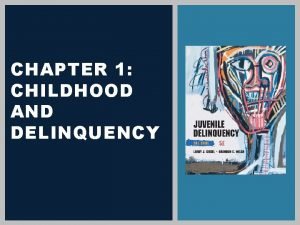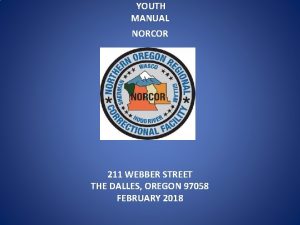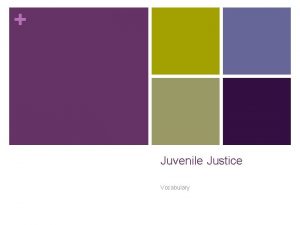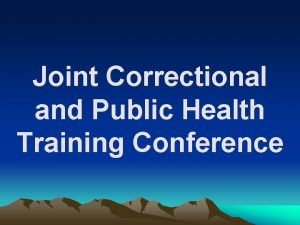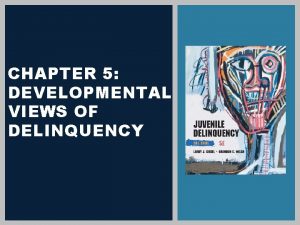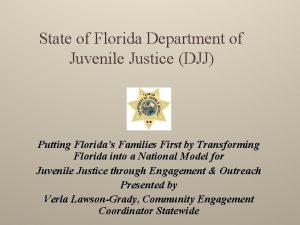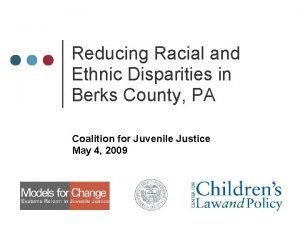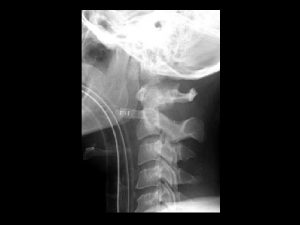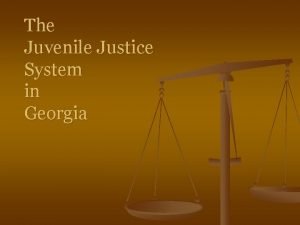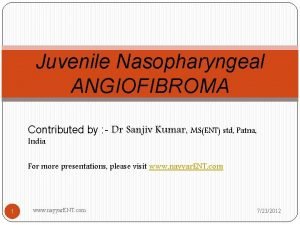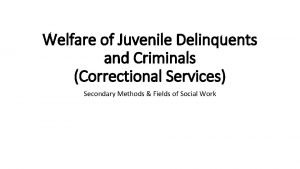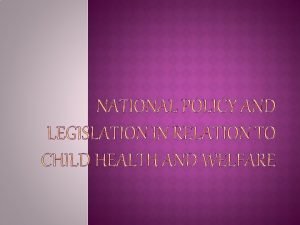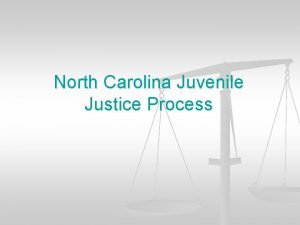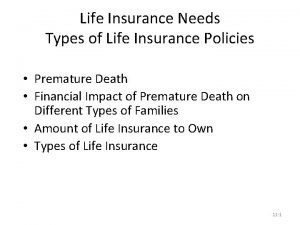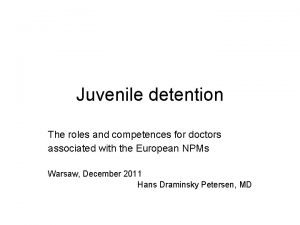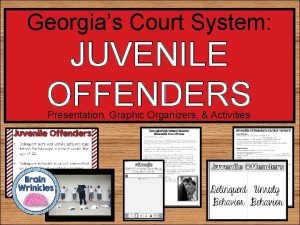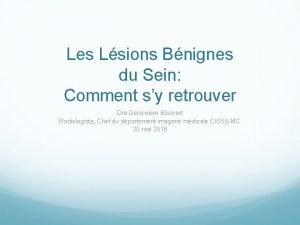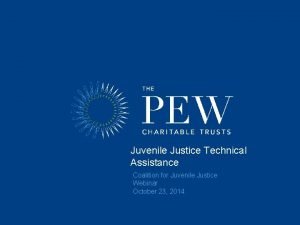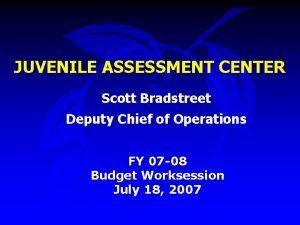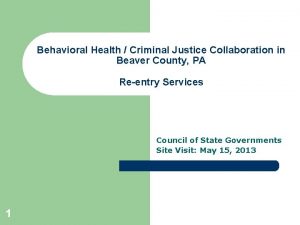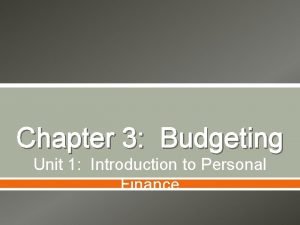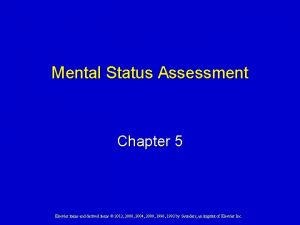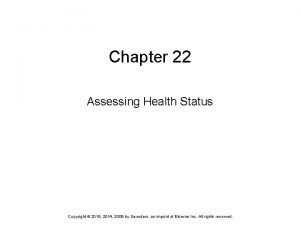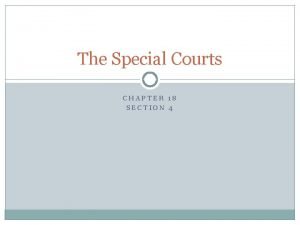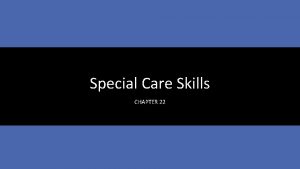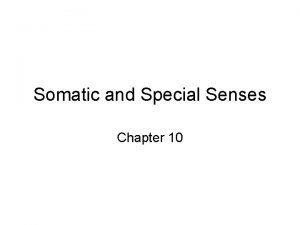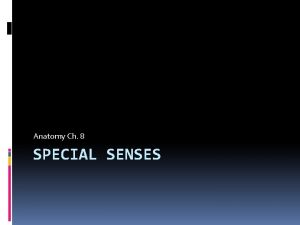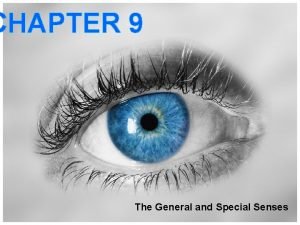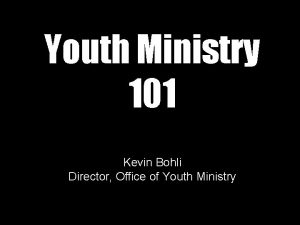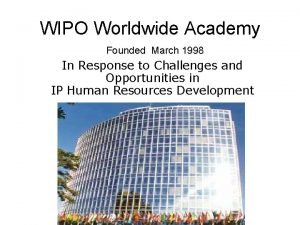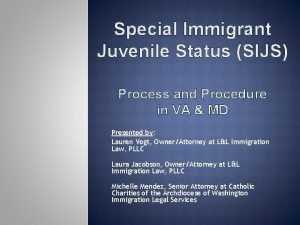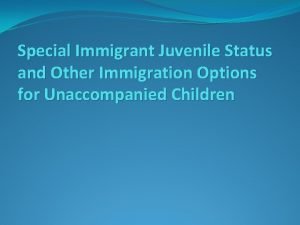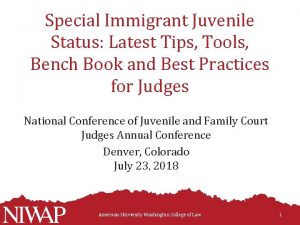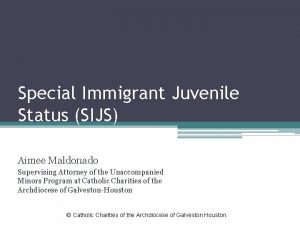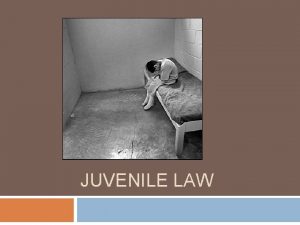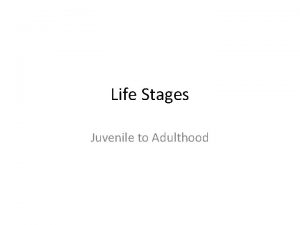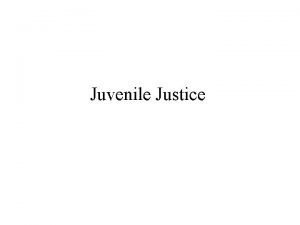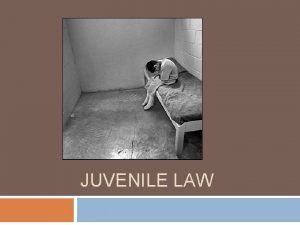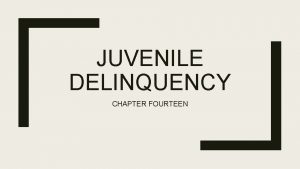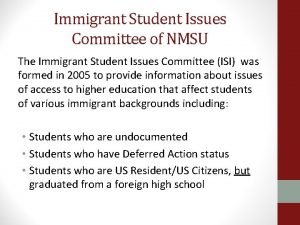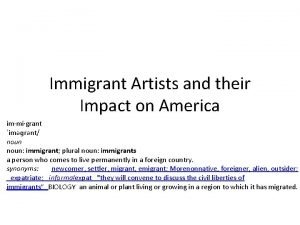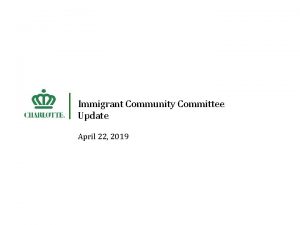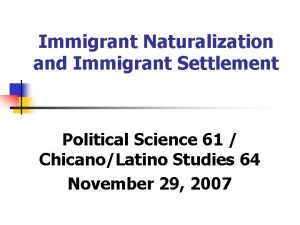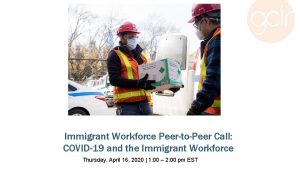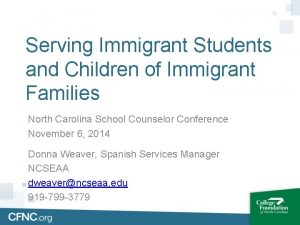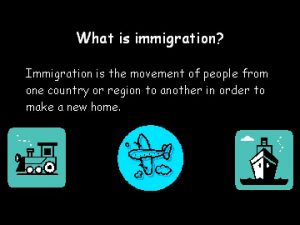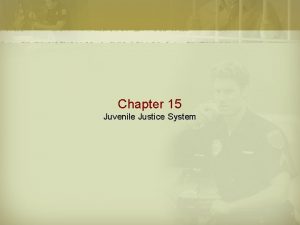Special Immigrant Juvenile Status 101 AILA NY Chapter


















































































- Slides: 82

Special Immigrant Juvenile Status 101 AILA NY Chapter, Pro Bono Committee CLE October 26, 2020 Presented by: Josie Cardoso-Rojo, Esq. Senior Attorney, Kids in Need of Defense (KIND) Rebecca L. Sosa, Esq. & Justyna Gawel, Esq. Sosa Law Natalia Lucak, Esq. Special Projects Supervising Attorney, Catholic Charities Community Services Alexandra Rizio, Esq. Managing Attorney, Training and Partnerships, Safe Passage Project

Agenda � Introduction to SIJS Basics � Statutory authority, definitions, and elements of SIJS � Overview of Family Court Process � Filing Form I-360 with USCIS � Filing Form I-485 and I-765 � Visa Bulletin � Defensive Cases Only � Policy Changes Over the Past Several Years � Ethical Issues in SIJS Cases � SIJS During COVID

The Law on SIJS FEDERAL AND STATE

What is Special Immigrant Juvenile Status? � SIJS is a form of immigration relief available to certain undocumented immigrant youth who are under the age of 21, unmarried, and who have been abused, neglected, or abandoned by one or both parents. � Granted by USCIS based on state court findings � Protects a young person from deportation � A pathway to permanent residence and work authorization � NOTE : A child granted SIJS can never sponsor his/her parent, even after citizenship

Immigrant Children and U. S. Law � Special Immigrant Juvenile Status 8 U. S. C. § 1101(a)(27)(J), 8 CFR 204. 11 � � � Under 21 Unmarried Dependent on a Juvenile Court or Placed in the Custody of an Individual/Entity, Agency, or Juvenile Court Reunification with One or Both Parents not Viable Due to Abuse, Abandonment, Neglect or “Similar Basis” under State Law Not in Child’s Best Interests to Return to Country of Origin or Last Habitual Residence

Three Stages of SIJS Stage 1: State court predicate order from New York Family Court Stage 2: Petition USCIS for SIJ status Stage 3: Apply for Lawful Permanent Residence

SIJS: Affirmative v. Defensive Claims Affirmative Posture � � Hearings in Family Court Form I-360 and Form I 485 submitted to USCIS � � � Depending on where the client is from, may be able to submit both forms to USCIS at the same time. Check Visa Bulletin. Children from El Salvador, Guatemala, Honduras cannot file the I-485 and I-765 until their receipt date becomes “current” Defensive Posture � � Hearings in Family Court AND Immigration Court Submit Form I-360 for SIJS to USCIS Make Motion to be Placed on Status Docket - if at 26 Federal Plaza Once I-360 is approved and priority date current, submit Motion to Terminate proceedings and adjust status before USCIS, OR adjust status in Immigration Court.

The Logistics of SIJS FAMILY COURT, USCIS, IMMIGRATION COURT, OH MY!

Family Court Stage: Step by Step 1: File Petition for Custody/Guardianship in Family Court Step 2: Serve Petition/Summons on Respondent Parent(s) (or Seek to Waive) Step 3: Submit Special Findings Motion - Evidence of Parental Malfeasance and Brief Step 4: Inquest on Merits Step 5: Special Findings Order

Custody vs. Guardianship Custody � Child is under 18 � Generally, only parent/guardian may petition � Non-parent may petition in “extraordinary circumstances” � Respondent parent generally must be personally served � Fingerprinting and background checks generally NOT required Guardianship � Child is under 21 � Child may self-petition if over 14 years-old � Guardian doesn’t have to be related to the child � Service might be waived on respondent parent(s) in cases of abandonment under SCPA Section 1705 � Fingerprinting and background checks generally required for all adults 18 years old or older in household

Service of Process � Governing Rules: � Civil Practice Law and Rules (“CPLR”) § 308 � Personal Service is generally required for service of the petition. � Summons needs to be translated into parent’s native language. � Motion and supporting documents may be served by DHL/Fed. Ex � Affidavit and Proof of Service must be provided to the Family Court, preferably in advance of initial hearing � TIPS � Determine if Hague Convention of Service Abroad of Judicial and Extrajudicial Documents in Civil or Commercial Matters applies � Determine if you can prepare Motion to Waive Service � Determine if Respondent parents consents to waive service in guardianship cases

Special Findings Motion � � Notice of Motion Memo of Law in support of Guardianship/Custody and Special Findings Proposed Special Findings order (GF-42) Exhibits � � � Affidavit of child, guardian/custodian Birth certificates and affidavits of translation Identity documents Other relevant evidence as needed (death certificates, hospital records) Country conditions? Deadline: Generally 8 days in advance of inquest hearing, but always check with judge

SIJS Eligibility under New York Law (Briefly) � “Dependency” � � Established when Family Court appoints a guardian to the juvenile. In Re Attowa Mc. D. 50 A. D. 3 d Best Interests � Totality of circumstances affecting physical and psychological welfare, health, happiness, education, shelter, hopes for the future, means of support if deported. Matter of Stuart, 280 N. Y. 2 d 245, 250(1939); Matter of Trudy-Ann W. , 901 N. Y. S. 2 d 296, 297 (N. Y. App. Div. 2010); Matter of Alagmir, 917 N. Y. S. 2 d 309, 312(N. Y. App. Div. 2011).

SIJS Eligibility under New York Law (Briefly) � Abandonment � � Abuse � � Causing or allowing physical injury or severely impairs emotional health. Fam. Ct Act 1012(f) Neglect � � � Parent evinces intent to forego parental rights by failing to visit or communicate, though able to do so. Soc. Svcs L 384 -b(5) Failure to exercise a “minimum degree of care” Fam. Ct Act 1012(f); Social Svcs L 371 4 -a(i) Abandoned” under NY Law “Other Similar Basis” � Death of a parent, (Matter of Luis R. v. Maria Elena G. , 120 A. D. 3 d 581, 582 (2 d Dept. 2014) ; New York Family Court Act 1092(a)(2)(i) (Destitute Child statute))

First Appearance Before the Family Court � Complete prior to First Appearance � Attempt to complete personal service of process of Guardianship/Custody petition and Special Findings Motions (if possible) on respondent parent(s) � � Have household members age 18 and older be fingerprinted at the Family Court (if applicable) � � If not possible, prepare Motion to Waive Service If not possible, prepare Motion to Waive Fingerprints for first hearing During First Appearance, Family Court Judge reviews the logistics of the case � � Service of Process Reviews results from OCFS 3909 (if applicable) Reviews fingerprint results (if applicable) Reviews Motions before the Court

The Inquest = the substantive hearing � � Direct Examination of Client and proposed Guardian/Custodian Topics to cover � � � � Child’s age/marital status Guardian’s employment, ability and willingness to support child Whereabouts or malfeasance of respondent parent(s) Why the proposed guardian/custodian is an appropriate person to care for your client Nature of abuse, neglect, or abandonment How is the proposed guardian/custodian supporting child’s best interests? Why it is not in child’s best interest to return to country of origin/country of last habitual residence

The Coveted “Special Findings Order” ● GF-42 on the NYC Family Court Website ● Must include sufficient factual detail for each finding ● Cite to NY statutes and case law, preferably in your department. ● Include factual basis of why it’s not in the child’s best interest to be returned to home country.

PRACTICE TIPS! � Review your Orders Carefully � � � Child’s name Child’s date of birth Guardian’s names Parent’s names Child’s country of nationality Is there support for each ground � � Abuse Neglect Abandonment Death as a Similar Basis

SIJS Ethical Issues: Beware of Age-Out Cases � � � USCIS must receive the Form I-360 SIJS Petition by the day before the Child’s 21 st Birthday Mailbox rule does NOT apply If Child’s 21 st birthday is on a Saturday, Sunday, or Monday, the application needs to arrive by the Friday before. Tip: Calendar an early “fake deadline” See NY Rules of Professional Conduct on Competence, Diligence, and Communication. (Rules 1. 1, 1. 3, 1. 4)

Stage 2: File I-360 SIJS with USCIS Stage 1: State court predicate order from New York Family Court Stage 2: Petition USCIS for SIJ status Stage 3: Apply for Lawful Permanent Residence

Stage 2: Filing Form I-360 SIJS w/ USCIS Checklist for Filing ● ○ ○ ○ ○ ● ● Brief cover letter listing documents submitted and summarizing eligibility for SIJS Form I-360, filled out and signed ■ If child is 14 or older, he/she can sign their Form I-360 G-28 notice of appearance of counsel Copy of Special Findings Order Copy of Guardianship Order (optional but path of least resistance) Birth Certificate and certified English translation I-360 must be in the hands of USCIS, at the latest, by the day before the child’s 21 st birthday. There is no filing fee for the I-360 based on SIJS If client is NOT in removal proceedings and is NOT from a retrogressed country, can also file the I-485 and I-765 at the same time. � Check DOS Visa Bulletin

Stage 3: File I-485 + I-765 Stage 1: State court predicate order from New York Family Court Stage 2: Petition USCIS for SIJ status Stage 3: Apply for Lawful Permanent Residence

Applying for Lawful Permanent Residence: Special Immigrants & the Numerical Limit � � � SIJS cases are “Special Immigrants” counted under the Employment-Based preference category E 4 (=EB -4) There approximately 10, 000 green cards available annually to all “special immigrants” Per-country limit for preference immigrants is set at 7% of the total allowed fiscal year limit ➔ If USCIS receives more than 7% of applications from people from a specific country for a particular preference category, applications from that country will be backlogged

What Does This Really Mean for My Client? ● Applying for their green card also means they can apply for a work authorization and get a Social Security number. ● The majority of SIJS clients likely have to wait a long time in order to be able to apply for their green card. ● Most common examples: 1. All clients from El Salvador, Guatemala, Honduras, and sometimes Mexico, have a long wait before they can apply for AOS and EAD. 2. Clients in removal proceedings have to either Adjust before EOIR, or terminate removal proceedings and Adjust before USCIS (less likely now in Oct. 2020). ➢ So it’s key to screen and rescreen for all available options of relief.

SIJS Ethics: Monitor the Visa Bulletin � � What does this mean for you as the Attorney? SIJS Ethical Tips: Attorneys must monitor the Visa Bulletin – best practice is once per month. Current wait time for some visas is approximately 3+ years (e. g. Northern Triangle Countries) Attorneys must have a system in place to track Priority Dates for SIJS cases and identify when client’s cases will be eligible to Adjust Status.

SIJS Ethics: Monitor the Visa Bulletin � � Ethics Rules: Multiple Duties cover this kind of need for case monitoring: Duty of Competence, Rule 1. 1; ➢ a lawyer shall provide competent representation to a client � Duty of Diligence, Rule 1. 3 ➢ a lawyer shall act with reasonable diligence and promptness; shall not neglect a legal matter entrusted to the lawyer � Duty of Communication, Rule 1. 4 ➢ promptly inform the client of material developments in the case, and keep the client reasonably informed about the status of the matter

Checking the Visa Bulletin: When can my client file her I-485 & I-765? � Checking if your client can file for her green card (I-485), and I-765 work authorization, is a 2 -step process: Step #1: Check USCIS’s website to determine which Visa Bulletin chart to use: www. uscis. gov/visabulletininfo � SIJS cases fall under “Employment-Based 4 th Category” = E 4 (= EB-4) � This tells you which Visa Bulletin chart to use, either the “Final Action” dates chart (Chart A), or the “Dates for Filing” chart (Chart B). Step #2: Check your client’s Priority Date against the USCIS-indicated Visa Bulletin chart for that month. https: //travel. state. gov/content/travel/en/legal/visa-law 0/visabulletin/2021/visa-bulletin-for-october-2020. html

Let’s Check Out the Visa Bulletin for October 2020 � Step #1: Check USCIS’s website to determine which Visa Bulletin chart to use

October 2020 Visa Bulletin: Chart B Dates for Filing Step #2: ● Look at the Employment. Based 4 th category for SIJS ● If “C” = “Current” then you can File Forms I-485 + I-765 (i. e. Mexican nationals) ● If there is a date listed, like “ 01 Feb. 2018”, then you can file when your client’s I-360 SIJS Priority Date is earlier than this “Dates for Filing” Date listed.

October 2020 Visa Bulletin: Chart B Dates for Filing Right now in October 2020, children from El Salvador, Guatemala & Honduras can only file their I -485 + I-765 IF their I-360 SIJS Priority Date is BEFORE this “Date for Filing” date of February 1, 2018. � Note: although USCIS will not adjudicate the I-485 until Chart A—the Final Action Date—is current, in the meantime, the client can apply for their green card, work authorization, and social security card.

USCIS applies the Visa Bulletin based on the date USCIS RECEIVES the application � � � USCIS posts the current month’s Visa Bulletin, and then around the third week of the month, they post the upcoming month too. USCIS applies the Visa Bulletin based on the date USCIS receives the application. Example from October 2020: If your client from Guatemala has a SIJS I-360 priority date of January 31, 2018, or earlier, then USCIS can receive their I-485 on October 1, 2020 and through the month of October, because that priority date is current for October 2020 Visa Bulletin. ➔ Beware of retrogression!

Filing for Lawful Permanent Residence � � � Application for LPR (Form I-485) and Work Permit (Form I-765) � Fingerprinting (criminal background check) � Medical exam by USCIS Civil Surgeon Fee Waiver - Submit Form I-912 � USCIS Fee Increases Enjoined - Apply! Selected grounds of “inadmissibility” are inapplicable to SIJS kids

Oh No! USCIS Wrongfully Rejected my client’s SIJS Application or Fee Waiver! Contact the USCIS Lockbox at this email: lockboxsupport@uscis. dhs. gov � � � Email Subject - ATTN: SIJS I-360 Attach G-28 Provide Client’s name, A#, DOB, and address Briefly explain why it was wrongfully rejected Ask to correct + backdate to the original timely-filed receipt date

Defensive Cases Only: Immigration Court Appearances � � � Inform the IJ of all types of relief the client is seeking (i. e. SIJS and asylum) Request adjournment: to prepare case, or to pursue relief out of court Once I-360 is pending, file a motion to place the case on the status docket Once I-360 is approved, case may be kicked off the status docket and may need to file or renew applications for relief (e. g. , asylum) Schedule an individual hearing (asylum cases)

Defensive Cases Only: The Status Docket � � Status Docket Memo implemented inconsistently in the NY Courts � I-360 pending - Category 1 Status Case � I-360 approved - Unclear Further reading and research Safe Passage Project analysis https: //www. safepassageproject. org/2019/09/eoir-policymemo-19 -13 -use-of-status-dockets-how-the-courtadministration-is-constraining-local-control/

Defensive Cases Only: I-360 Approvals and the Status Docket � “A status case is (1) one in which an immigration judge is required to continue the case pursuant to binding authority in order to await the adjudication of an application or petition by U. S. Citizenship and Immigration Services (USCIS) ● See Sample Status Docket Motion for Pending I-360 and Sample Status Docket Update in the Materials ● What about if your client’s I-360 has been approved? ○ Case may be “kicked off” the status docket and scheduled for a master calendar hearing ○ May need to screen client for additional forms of relief (i. e. asylum)

SIJS Ethics: Duty to Timely Update the Court regarding I-360 Approvals � In a footnote on page 4, the Status Docket Memo provides: Consequently, for category (1) cases, regardless of whether a call-up date has been issued, EOIR expects that either party will timely inform the court when USCIS has rendered a decision on an underlying petition or application. A practitioner's intentional or knowing failure to timely inform the immigration court of the disposition of an underlying petition or application adjudicated by USCIS may be grounds for referral for possible disciplinary action. See, e. g. , 8 CFR § 1003. 102 G), (o), (n), (q) (disciplinary grounds for practitioners related to frivolous behavior, competence, prejudicial conduct, and diligence). ● So what is “timely”? ○ As soon as you receive the I-360 approval notice? ○ At any time so long as it’s before your “call-up” or status due date?

Adjustment of Status For Clients in Removal Proceedings If your client’s priority date is current and they are in removal proceedings before the New York Immigration Court, then: 1) Email Duty-Attorney. NYC-OCC@ice. dhs. gov with your client’s name and A# and ask their position on a potential motion to terminate Join? Non-opposition? If OCC joins, more likely the IJ will terminate removal proceedings so your client can pursue green card before USCIS; � Even if OCC refuses, you can still file MTT � �

Adjustment of Status Before the New York Immigration Court ● Must follow Pre-Order Instructions and file copies with USCIS: ○ Clear copy of your client’s Form I-485 ○ Copy of G-28 ○ Check or money order for application and biometrics fee (or Immigration Judge’s Order granting fee waiver) ○ Copy of the Pre-Order Instructions ● NOTE - New address for Texas Service Center

Strategies for litigating SIJS cases in removal proceedings � � If your client’s case is in removal proceedings, it’s very important to be strategic in today’s climate in immigration court Plan and litigate with this thought at the forefront of your litigation strategy: how do we keep this SIJS case alive in removal proceedings?

Strategies for litigating SIJS cases in removal proceedings: General Tips: Full Court Press Don’t let DHS get away with not meeting their burden!! � Make motions in writing � State objections on the record, if appearing in person/by phone � State every possible objection (within reason) � Continue to request administrative closure, placement on the status docket, or in the alternative, long continuances. �

General Tips: Full Court Press: Hold DHS to its Burden �Remember that it is DHS’s burden to prove alienage. MAKE THEM. � Even if DHS comes back to the next hearing with your client’s birth certificate, you can (in the interim) move forward with family court case, and you have bought your client valuable time towards the running of the visa bulletin.

Still Seek Admin Closure, Status Docket, and Continuances while you pursue SIJS as a Defense � � It is key to continue to advocate for the use of reasonable docket management tools such as the Administrative Closure, Status Docket, and Continuances. Resources: CLINIC sample motion which includes admin closure arguments

Still Seek Administrative Closure while you pursue SIJS as a Defense � Admin closure is not dead!! You can still ask for it. Cite to circuit cases that strike down Castro-Tum --> admin closure! WINS (i. e. Castro Tum is overturned by a Circuit court): � 7 th Circuit; 4 th Circuit PENDING CHALLENGES � Second Circuit: No. 18 -3460, Benitez Marquez v. Barr � Third Circuit: No. 19 -2681, Ramos-Padilla v. Att'y Gen. � Sixth Circuit: No. 20 -3175, Hernandez-Serrano v. Barr � Ninth Circuit: No. 19 -70964, Umana Escobar v. Barr � Tenth Circuit: No. 20 -9559, Acuna-Prieto v. Barr � � �

Seek Continuances for “collateral” matter of SIJS as a Defense even under Matter of L-A-B-R � � “After L-A-B-R-, practitioners may support a motion for a continuance in this situation by showing a likelihood that the state court order will be obtained and will materially affect the outcome of the removal proceedings. Obtaining a qualifying predicate order is likely to materially affect the outcome in removal proceedings because it allows the child to immediately file a petition with USCIS for SIJS, which, if granted, provides a basis for adjustment of status. ” See CLINIC’s Practice Advisory: Matter of L-A-B-R-, 27 I&N Dec. 405 (A. G. 2018), available at: https: //cliniclegal. org/resources/removalproceedings/practice-advisory-matter-l-b-r-27 -dec-405 -ag-2018

Policy Changes Over the Past Several Years

USCIS Adjudication Trends for I-360 SIJS � � RFE, NOIDS or Denials regarding USCIS’s “Consent function”--a denial by any other name… Real issue is: � Sufficiency of SIJS Order (USCIS challenging SIJS orders that do not contain proof of state law basis, or proof of factual basis, esp. in over-18 cases); challenging cases youth with “inconsistencies” in previous immigration history.

R. F. M. v. Nielsen Class Membership � If you have denials for over-18 youth, CONTACT CLASS COUNSEL AT LEGAL AID! � Elizabeth Rieser-Murphy at eriesermurphy@legal-aid. org and Beth Krause at bkrause@legal-aid. org � I-290 Bs for RFM Class Members must be filed by May 31, 2021 and are fee exempt. You do NOT need to file an I-912 or pay the fee.

Ethical Issues in SIJS Cases Thinking through the basic steps of a SIJS case, where do ethical issues often arise? Common Scenarios and Recommended Best Practices NY Rules of Professional Conduct are available at: http: //www. nycourts. gov/Legacy. PDFS/rules/jointappellate/ NY-Rules-Prof-Conduct-1200. pdf

SIJS Ethics: Step #1: Determine who you are representing. The first step is always to think through who you are representing. � Who is your client? � Who is NOT your client? � Everything else flows from this decision. � All of your ethical obligations attach based on who you are representing. � � Best Practice Summary: Represent only the child in a SIJS case, and represent the child in Family Court Proceedings.

SIJS Ethics: Different norms for Immigration Court and Family Court A key distinctions for SIJS cases: � In Immigration Court, dual representation is common and often makes sense where the family has the same common goal. � In sharp contrast, in Family Court, dual representation is not permitted and considered a conflict of interest. � General Family Court recommendation as a default position: represent the child, because if not, the Family Court will likely appoint an 18(b) panel attorney to represent the child. That is a wild card. � The guardian can proceed pro se. � As the Attorney for the Child, you can submit their petition. �

SIJS Ethics: Exceptions to representing the child �Exceptions: � If the child is so young that she cannot tell you the key facts of her case; or � If the child has diminished capacity issues. � Then consider representing the adult proposed guardian. �Example #2: Custody case with young children, the parent is likely to have the key facts, makes sense to represent the parent because for custody the parent files the petition. �Key caveat #1: be clear about the scope of representation. �Key caveat #2: be sure to advise the parent client that when a child obtains SIJS, that child can never petition for their parents to obtain immigration benefits, even for the non-abusive parent.

SIJS Ethics: Communicating with Children � � How do I communicate with a child client? See NY Rules of Professional Conduct, Rule 1. 14, Client with Diminished Capacity: “(a) When a client’s capacity to make adequately considered decisions in connection with a representation is diminished, whether because of minority, mental impairment or for some other reason, the lawyer shall, as far as reasonably possible, maintain a conventional relationship with the client. ” Summary: do the best you can to communicate normally, as you would with any other client. Follow their wishes to the extent it is reasonable to do so. � Guiding Principle: Meet the client where they are. �

SIJS Ethics: Best Practices for the Initial Consultation: Interview the Child Separately Always interview a child an adult separately, at least for some of the time. � Why? � Attorney-client privilege and other ethical duties begin even at the initial consultation, even though you do not yet represent anyone at this time. � As the Attorney, you owe the child client a Duty of Confidentiality at the consultation. See NY Rules of Professional Conduct, Rule 1. 6. � A child may not be living in a safe home environment, even with a biological parent or other adult.

SIJS Ethics: Duty of Confidentiality, Rule 1. 6 The Attorney owes a duty of confidentiality to the child. � See NY Rules of Professional Conduct, Rule 1. 6: � “A lawyer shall not knowingly reveal confidential information…” Rule 1. 6(a). � Explain confidentiality in child-friendly terms. � Ex: Everything we talk about today is confidential. That means I can not and will not share this information with anyone else, including the adult who brought you here today, unless you give me permission to do so. � Includes my notes. � Extends to everyone in my office. �

SIJS Ethics: Duty of Confidentiality, Rule 1. 6 � Exceptions to Confidentiality: Informed Consent. Rule 1. 6(a)(1). Example: With your permission, I can explain the legal options we’ve discussed with your parent or adult. � Client can revoke consent at any time, so check back in with client regularly throughout the representation. � Practice tip: Let the client guide what should be shared, with whom, and when. Remove your assumptions. � Exceptions to confidentiality: disclosure of hurting oneself or others, committing a crime → may need to share. � Attorneys are not mandatory reporters. �

Confidentiality is key to building Trust � � � � Conversations about Confidentiality can be helpful to build a relationship of trust with the client. SIJS kids are coming from cultures and homes where adults have harmed them or not been there for them. They often have had to keep the bad things that happened to them a secret. Establish rapport by asking about casual, getting-to-know-each other topics, like school, hobbies, life… gradually ease into difficult conversations slowly. Patience is key. Plan to meet several times on their terms. Let them guide the pace, and that they guide what they are comfortable talking about today. Explain why you need information that is difficult to talk about, and thank them for sharing. Avoid cross-examining (unless it’s a trial prep), but defer tough questions to other people (“the Judge may ask…”

SIJS Ethics: Duty of Competence � � � Attorney’s Competence: Determine potential avenues of legal relief for children, most common are SIJS and asylum for the child. See NY Rules of Professional Conduct Rule 1. 1: “(a) A lawyer should provide competent representation to a client. Competent representation requires the legal knowledge, skill, thoroughness and preparation reasonably necessary for the representation. ” “(b) A lawyer shall not handle a legal matter that the lawyer knows or should know that the lawyer is not competent to handle, without associating with a lawyer who is competent to handle it. ” Tips: Ok to team up with a colleague, get a second opinion, etc. Doing pro bono work with a mentor is a great way to gain competence. (See last slides on how to sign up for pro bono work. )

SIJS Ethics: Twin Pillars of Communication & Informed Consent � � Communication: Rule 1. 4: “(b) A lawyer shall explain a matter to the extent reasonably necessary to permit the client to make informed decisions regarding the representation. ” Informed Consent: Rule 1. 0(j): “Informed consent” denotes the agreement by a person to a proposed course of conduct after the lawyer has communicated information adequate for the person to make an informed decision, and after the lawyer has adequately explained to the person the material risks of the proposed course of conduct and reasonably available alternatives. ”

SIJS Ethics: Twin Pillars of Communication & Informed Consent ● Explain pros and cons of each potential avenue of relief. ● Explain the timing of key milestones, like when the child may likely be able to apply for their I-485 and I-765 work authorization, based on: ● Different procedures for Affirmative vs. Defensive cases; ● Wait times based on Country of Origin + Visa Bulletin; ● Compared to alternative forms of relief, like Asylum. ● Explain potential risks: NTA policy means the child must understand she will likely get placed in proceedings if USCIS denies SIJS. ● SIJS: explain that even if the child wins this case and gets a green card, she can NEVER petition for their parent, even when there are no claims against that parent → This may impact their decision to pursue SIJS

SIJS Ethics: Informed Consent from Child Clients Remind the child that you are representing their goals, their voice and they are in charge of making decisions in their case. � Put the child in the driver’s seat, making her own decisions based on your legal counsel. � Cultural context: Remember that a child’s place in most societies is one of obedience at the lower end of a hierarchy. This is likely the first time a child has ever met a lawyer, let alone had one representing them. � Practically: check in often to review the big picture of where you are in the case, the next 3 steps in the case, and legal strategy. �

SIJS Ethics: An adult can pay for the child’s legal fees with informed consent. A third party, like an adult, can paying for the child’s legal fees. � The Retainer Agreement should include: � (1) Child Client’s informed consent to 3 rd party payor; � (2) that there is no interference with the lawyer’s independent judgment or with the attorney-client relationship; � (3) the client’s information is kept confidential; � (4) unless the child has asked to share that info with the adult. � See NY Rules of Professional Conduct, Rule 1. 8(f), Rule 1. 6. �

SIJS Ethical Issues: Selecting a Guardian Family Court Act § 657(c) provides that an order of guardianship under Family Court Act § 661 conveys “the right and responsibility to make decisions, including issuing any necessary consents, regarding the child’s protection, education, care and control, health and medical needs, and the physical custody of the person of the child. ” � Qs for the Child (assuming this is your client): � Is this who you want to have the authority to make medical decisions for you in case of emergency? � Is this who you want to have the authority to make decisions about your education? � Is this who you want to make decisions about where you live? �

SIJS Ethical Issues: Screening the Guardian Qs for the Proposed Guardian (assuming not your client) � Start with reminding them that you are doing a brief screening of them for Guardianship, but that you do not represent them in any capacity, you only represent the Child. � Be clear that they have a right to seek their own counsel if they need legal guidance, and may want to do so. � Refer them to: Action NYC for a free immigration screening (1 -800 -354 -0365 or 311 and say Action. NYC) � https: //www 1. nyc. gov/site/immigrants/help/legalservices/actionnyc. page � https: //www. immigrationlawhelp. org/ �

SIJS Ethical Issues: Screening the Guardian Qs for the Proposed Guardian: (not your client) � What ways are you willing to provide support to this child? � Have you had any previous contact with: � (1) Immigration? (2) Criminal Court? (3) Family Court? � � Undocumented is ok but no guarantees; low risk, not “no risk” � Previous removal order is a hard “no” � Criminal convictions are a hard “no” � � Assume that the process of fingerprinting will reveal a removal order AND send that information to ICE. Fingerprinting and OCFS 3909 extend to all people over 18 living in the Guardian’s home, so you must inquire about family members who may be at risk of ICE enforcement.

SIJS Ethical Issues: Screening the Guardian Qs for the Proposed Guardian: (not your client) � Previous Family Court contact, ACS involvement, a social worker visiting the home is a reason to pause and ask questions. Q: Has a Social Worker ever come to your home? � Occasionally adults don’t remember, and then you are caught by surprise at the hearing when the SCR and fingerprint results come back. � Key Point: while you draw the line that you don’t represent the Proposed Guardian, you still need to consider these issues because it’s against your Child client’s interest to have a supportive adult in their lives deported for trying to step up and support them. �

SIJS Ethical Issues: Define the Scope of Representation in the Retainer Agreement SIJS is a multi-part process that involves multiple city and federal government agencies; � SIJS can take years; � Involves other people who are not your clients; � Involves very sensitive, confidential client information; � Your client may also be pursuing other relief in addition to SIJS � So… be sure to define the Scope of Representation in your Retainer Agreement. � See Rule 1. 5, Fees �

SIJS Ethical Issues: Case Management Duties � � � � Case Management: Beware of Age-Outs! Keep track of deadlines, court dates, and client birthdays (for age-out issues), Priority Dates, Visa Bulletin, and ability to file for I-485 + I-765, updates to Immigration Court if in removal. Keep track of your clients: stay in touch, get updated contact information, addresses. Manage number and type of cases. Work with your supervising attorneys and proactively bring issues to their attention. Attorney work overload is common in NYC legal community, but it can hurt clients and create liability. Duty to supervise all non-legal staff (paralegal, receptionist).

Key Point: Seek Guidance and Mentorship for Ethical Issues and for Competence � � You are not alone! Ask for guidance and mentorship from your colleagues and supervisors. Analyzing ethical issues is a normal and important part of our practice as attorneys, especially when we work with immigrant population. Two heads are better than one. Involve your supervisors as early as possible to get guidance. If you do mess up, it’s ok. Do damage control. Do not bury your head in the sand. We are, after all, only human. Mistakes happen. Take a deep breath, get support, mitigate harm.

Helpful Ethical Resources � Read the NY Rules of Professional Conduct, available at: http: //www. nycourts. gov/Legacy. PDFS/rules/jointappellate/NYRules-Prof-Conduct-1200. pdf � AILA has an Ethics Compendium with immigrationspecific ethical guidelines and analysis. https: //www. aila. org/practice/ethics/compendium? utm_source=aila. org&utm_medium=Featured. Search � The NYC Bar Association has an Ethics website, advisory opinions, and an Ethics Hotline: http: //www. nycbar. org/member-and-career-services/ethics � Obtain Professional Liability / Malpractice Insurance, and contact them if you think there may be a potential claim against you.

SIJS During COVID-19

NYC Family Court – SIJS-related Filings � NYC Family Courts closed to public � � All filings via EDDS � � Except Nassau/Suffolk Except Suffolk County Only 45 -Day Age-Outs and emergencies due to COVID are being heard via Skype

NYC Family Court – SIJS-related Filings �Only scheduling: SIJS-related filings if the child will turn 21 within 45 days � Petitions involving the death of a parent or guardian within six months prior to filing the petition. � TIP: File via EDDS to secure a place in line! �

NYC Family Court – Emergency Filings � Emergency? File an Order to Show Cause (OSC) � � � Be prepared to file everything (or as much as possible) at the same time Flag the emergency in as many places as you can! � � Age-Outs COVID-related emergencies Death of a parent Upcoming immigration hearing I. e. “ 45 -DAY SIJS AGE-OUT” Made a mistake? E-mail the Court; DON’T refile.

OSC Denied? � If a jurist will not agree to move forward without: � Fingerprinting � OCFS 3909 SCR report � Service to parents who have abandoned and/or whose address is unknown � Denies Guardianship or SIJS � � Don’t give up! Ask for alternatives, cite to case law, etc. If all else fails, request a written order so that you can appeal it!

Service of Process during COVID � � Mail/courier delays due to COVID Inability to notarize documents Substituted Service � By mail to last known address � via Facebook � via Whats. App Save any response you may have gotten to confirm receipt of documents!

Silver Linings COVID has resulted in many NYC Family Court Judges and Referees resolving cases on the papers without a hearing, or with virtual hearings via videoconference. � COVID has forced the courts to find creative alternatives to fingerprinting, service, that may help make the courts more comfortable with these alternatives going forward. � � Pictures in lieu of home studies � Affidavits in lieu of fingerprinting � Substituted service

Virtual Hearings � Family Court uses Skype Business � � Court Attorney sends a link to enter the hearing First Appearance � � Speak to client about access to technology before the hearing: https: //www. youtube. com/watch? v=di. Jnv. Kc 9 lp. E&t=15 s Child and guardian may not be required to appear for first appearance Inquest/Merits Hearing � Child and guardian may be asked to appear via Skype. Remember to request interpreter, if necessary!

Working with Children Remotely Conduct calls using video – through Whats. App or Facetime � Specifically request the child to find a private space in their home so they can, hopefully, speak freely � In the alternative, ask your client to use headphones to safeguard their privacy/confidentiality as much as possible �

SIJS Ethics: Gain Competence and Help a Child in need by taking on a Pro Bono Case! ● Remember our Ethical Duty of Competence under Rule 1. 1? ○ competence = sufficient legal knowledge, skill, preparation for the many-aspects of SIJS cases to handle the case. ○ can associate with an attorney to gain competence - like mentorship ● A great way to gain competence in SIJS cases is to take on a pro bono case with one of our local non-profits.

SIJS Ethics: Competence through Pro Bono work with Mentorship When you work with a SIJS mentor on a pro bono case, you’ll have someone to call to troubleshoot case specificissues and ethical issues. � Catholic Charities, KIND, and Safe Passage Project have expertise in SIJS, working with immigrant youth, and mentoring pro bono attorneys. � You’ll have access to samples, templates, and be better able to track updates in SIJS cases. � When you work with a SIJS mentor on a pro bono case, you’ll have someone to call to troubleshoot case specificissues and ethical issues. � Pro Bono work counts towards completion of your 50 hours of pro bono work in NY under Rule 6. 1. �

THANK YOU! Questions? Pro Bono Opportunities? Natalia Lucak Josie Cardoso-Rojo Catholic Charities NY Natalia. Lucak@archny. org https: //www. catholiccharitiesnyprobono. org/ Kids in Need of Defense (KIND) jcardoso-rojo@supportkind. org https: //supportkind. org Rebecca Sosa & Justyna Gawel Alexandra Rizio Sosa Law Sosa. Law. NYC@gmail. com Info. Sosa. Law@gmail. com www. Sosa. Law. nyc Safe Passage Project arizio@safepassageproject. org www. safepassageproject. org
 Aila hartikainen
Aila hartikainen Timo aila
Timo aila Timo aila
Timo aila Vulnerable definiton
Vulnerable definiton Migrant hostel analysis
Migrant hostel analysis Immigrant power and control wheel
Immigrant power and control wheel Emigrant v immigrant
Emigrant v immigrant An immigrant is someone that is
An immigrant is someone that is Cabrini center for immigrant legal assistance
Cabrini center for immigrant legal assistance Sjpu
Sjpu Argo.status 101
Argo.status 101 504 plan oklahoma
504 plan oklahoma Florida special district handbook
Florida special district handbook Juvenile act
Juvenile act Maricopa county juvenile court
Maricopa county juvenile court Fran carino juvenile law
Fran carino juvenile law Race matters for juvenile justice
Race matters for juvenile justice Pauciarticular juvenile rheumatoid arthritis
Pauciarticular juvenile rheumatoid arthritis Missouri juvenile officer performance standards
Missouri juvenile officer performance standards Department of juvenile observation and protection
Department of juvenile observation and protection Jda canada
Jda canada Juvenile law definition
Juvenile law definition Newspaper article on juvenile delinquency
Newspaper article on juvenile delinquency Juvenile delinquents act
Juvenile delinquents act Juvenile case management system
Juvenile case management system Fran carino juvenile law website
Fran carino juvenile law website Fran carino juvenile law
Fran carino juvenile law According to choice theorists offenders
According to choice theorists offenders Juvenile
Juvenile Importance of nature of delinquency
Importance of nature of delinquency Juvenile delinquency objectives
Juvenile delinquency objectives Norcor clothing
Norcor clothing Chapter 11 basic concepts street law
Chapter 11 basic concepts street law Poverty and juvenile delinquency
Poverty and juvenile delinquency 9344
9344 Miami-dade county juvenile services department
Miami-dade county juvenile services department Cottage reformatories
Cottage reformatories Drk juvenile center
Drk juvenile center Developmental views of delinquency
Developmental views of delinquency Juvenile biography
Juvenile biography State of florida department of juvenile justice
State of florida department of juvenile justice Berks county juvenile probation
Berks county juvenile probation Juvenile justice alternative education program
Juvenile justice alternative education program Juvenile rheumatoid arthritis
Juvenile rheumatoid arthritis Georgia juvenile justice system
Georgia juvenile justice system Transpalatal approach meaning
Transpalatal approach meaning Seminole county juvenile detention center
Seminole county juvenile detention center Categories of delinquent youth
Categories of delinquent youth Treatment of juvenile delinquency
Treatment of juvenile delinquency Juvenile justice act 2000
Juvenile justice act 2000 North carolina juvenile justice
North carolina juvenile justice Insurance
Insurance Management of juvenile delinquency
Management of juvenile delinquency Juvenile offenders comprehension check answers
Juvenile offenders comprehension check answers Juvenile justice system in georgia
Juvenile justice system in georgia Juvenile crime singapore
Juvenile crime singapore Fibroadénome juvénile
Fibroadénome juvénile Indeterminate sentencing juvenile
Indeterminate sentencing juvenile Coalition for juvenile justice
Coalition for juvenile justice Minnesota juvenile justice system
Minnesota juvenile justice system Orange county juvenile assessment center
Orange county juvenile assessment center Cjab
Cjab Section 1 budgeting 101
Section 1 budgeting 101 Chemistry 101 chapter 1
Chemistry 101 chapter 1 A full mental status examination example
A full mental status examination example Assessing health status chapter 22
Assessing health status chapter 22 Chapter 18 section 4 the special courts worksheet answers
Chapter 18 section 4 the special courts worksheet answers Special care skills chapter 22
Special care skills chapter 22 Thermoreceptors
Thermoreceptors Dope mnemonic emt
Dope mnemonic emt Chapter 17 special senses answer key
Chapter 17 special senses answer key Chapter 11 medical terminology learning exercises
Chapter 11 medical terminology learning exercises Anatomy and physiology chapter 8 special senses
Anatomy and physiology chapter 8 special senses Chapter 8 special senses
Chapter 8 special senses Chapter 10 special senses
Chapter 10 special senses The general and special senses chapter 9
The general and special senses chapter 9 Pearson
Pearson Chapter 15 special senses
Chapter 15 special senses Kevin bohli
Kevin bohli Wipo worldwide academy
Wipo worldwide academy Ocs architecture
Ocs architecture Stem robotics 101
Stem robotics 101 Uiuc physics 101
Uiuc physics 101

